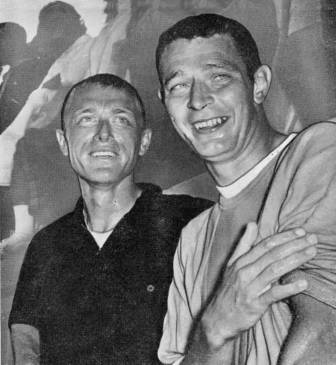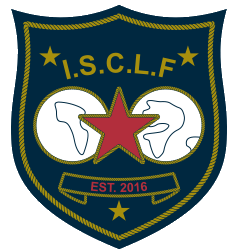Bill Buchan and Stars
By David Bolles

Bill Buchan (left) and Doug Knight won the 1961 Worlds
The Buchan family business in Scotland was tied to boats and fishing. In the early 1920’s they immigrated to the Pacific Northwest where they felt that they could continue their trade. Bill's father, while owning and operating a retail fish market in downtown Seattle, built a variety of sailboats boats for himself in his spare time during the late 1930’s and into the 1940’s.
Thus, when Bill saw the Stars gather in Seattle for the North American Championship in 1948 and decided, at the age of 13, that he wanted one of those boats, it was natural for his father to suggest that they should build one themselves. A major factor in the decision was that at the N.A.'s there were other sailors who were not all that much older than Bill was. Lowell North and Bill Ficker for instance, who were both in their teens, were there and instantly became his heroes.
It happened at this time near Bill's house in the Seattle neighborhood of Madison Park that there was a garage full of Stars, some 20 in all. It was the winter storage place for the Puget Sound Star Fleet. While he and his father got the plans to build a Star from the Class, they found it easier to go to the garage and measure the Stars that were there as well as to pick up on ideas for the construction of the boat. Somehow, the resulting boat was able to measure in as a legal Star. The boat was named "Torrid", # 2830, which was completed and registered in 1949.
The Buchans, father as crew and son, now 14, as skipper, started to race with the Puget Sound Fleet. The fleet was fairly active, with 20 or more boats turning out for the important races such as the Fleet Championship or what was then called the Pacific International Yachting Association Regatta where the Puget Sound Fleet would mix it up with the Canadians from the Vancouver area.
After a couple of years of sailing "Torrid" Bill became more acquainted with the finer points of boat construction in terms of taking advantage of the various tolerances which were allowed in hull construction and design. The Class was abuzz with what Skip Etchells was doing with his O.G.'s (from Old Greenwich Boat Co.). As a point of interest, Skip and his friend Bill Kelley actually built the first Etchells Star in the same Madison Park garage while they were employed in the Seattle shipbuilding industry during the war. Bill and his father then set about building a new boat which took advantage of some of these “builders tolerances”.
The resulting boat was "Bydand", #3213, built and registered in 1952. Bill went to Newport Harbor for the Christmas Regatta that winter to crew with another Seattle Star sailor where he saw George Fleitz, who was amazingly fast in his O.G. Wench IV, Star #2951. Fleitz had synthetic sails made by Kenny Watts which Bill had no idea even existed. Bill wanted to order a suit of these sails, but Watts didn't want to sell sails to someone who might make his sails look bad.
That summer, John Cram and his brother Wally showed up in Seattle with O.G. #3298, "Scram", and showed awesome speed in their O.G. as well, interestingly enough with cotton sails, also made by Watts. It was obvious to Bill that it was the O.G. boat and not necessarily the synthetic sails that were responsible for generating such performance. After looking at Cram’s boat Bill came to realize that there was more wiggle room in the hull tolerances than he thought possible. This was accomplished by utilizing what the Class called the “moving baseline”. By doing so, a boat could be flatter by 2” from the original plans instead of the 1” that he thought was the maximum and still measure in. That was enough to prompt Bill to build yet another boat, #3382, the first “Frolic”, in that same summer of 1953.
One of the other hallmarks of the O.G.'s, which wasn’t discovered until a couple of years later, was the wide bow. Skip had opened up the half beam measurement at station 1, a measurement that at that time wasn’t recorded on the certificate, making the stem more plumb which had the effect of increasing the sailing length of the Star. Realizing that, Bill performed major surgery on the “Frolic” the winter of 1956.
With the building of "Frolic" Bill became a builder of record in the Star Class Log, and Buchan Boats under the symbol BUC was listed in the 1954 Log.
Unfortunately, "Frolic" did not receive her measurement certificate by the time the North American Silver Star series of 1953 took place, and he and his father had to take "Bydand" to Milwaukee. They finished in the lower third of the fleet.
Since Bill couldn't get Watts to sell him sails he had a local sailmaker build him a suit from Dacron in 1954. He and his father participated in the 1954 N.A.'s, this time held at Rockport, MA. With the new boat and sails they were now whistling another tune and finished 15th out of 37. About this time Murphy and Nye began to make synthetic sails out of a fabric called Orlon, which were very successful so Bill began to buy sails from them in 1955.
After a few years of sailing the "Frolic" #3382 successfully in the 6th District and doing somewhat better at the 1958 and 1959 World's (9th and 10th) Bill decided to build a new "Frolic", #4260, during the winter of 1959/1960 in the garage of his new home on Mercer Island. With this "Frolic" Bill won the 1961 World's with Doug Knight crewing. The next year they went to the World’s at Cascais where they finished 4th. (Star #4260 stayed in Portugal and is presently being refinished by its owner Mario Guedes de Sampaio.)
In 1963 Bill built Star #4660, also named "Frolic". The main characteristic of #4660 was that it was narrow at the chine and wide at the sheer with minimum freeboard, as compared to 4260, which was a very narrow shape. Bill felt that this design might have better speed in strong wind conditions. With this boat Bill was 5th at the 1963 World's at Chicago. This was also the boat that he sailed at the 1964 Olympic Trials, held in Chicago too. Although the boat certainly performed well in the breezy races, Chicago, as we now know, isn’t really the “Windy City” that Bill thought it was.
Not being satisfied with that boat, he then built Star #4913 in the fall of 1964 and finished 3rd at the 1965 World's at Newport Harbor. This was followed by Star #5260, built in 1968, which was raced in the 1968 Olympic Trials in San Diego.
In 1968, because of a housing slowdown in the Seattle area, Bill's construction business tapered off. That, and the advent of fiberglass made it apparent that Bill might want to build Stars for a living. Fiberglass boats had become allowed by the Class by this time. A plug was built in Bill’s shop based on the lines of 4260, which seemed to him as the most well- rounded of all the boats he had built in the interim. The work of building the molds as well as the hulls themselves was done by the Clark Boat Co. in Kent, Washington. Bill brought the unfinished hulls back to his garage/workshop and finished them off there, working mostly on nights and weekends.
At first a very low-density foam core was used but that proved to be unsatisfactory. These boats started with #5333, which Bill sailed in the 1978 Worlds. He remembers Lowell North, Pete Bennett and Barton Beek also sailed his boats at that regatta. By the next year he switched to balsa core in the high load areas of the boats.
Bill won the World's at Marstrand with #5460 which was built utilizing the new lay up.
One of the early problems, which Bill encountered with the fiberglass boats was that there was a surprising amount of shrinkage. The molds had to exceed maximum length by a slight amount, for example, in order for the boats to measure in properly. New molds were built in 1971 for the 5600 series boats, many of which were delivered to their owners at the Seattle World’s Championship that summer. In 1973 Bill built a second boat for Lowell North, Star #5662. This boat won the 1973 World's for Lowell and then won the 1974 World's with Tom Blackaller at the helm.
The 5600 series molds were sent to Ron Anderson and Larry Whipple after the 1974 World’s so that the boats could be built someplace else since Bill’s construction business was now taking all of his spare time. Sometime later the molds were brought back to Seattle and were eventually sold to a group of people in Brazil.
With his son Carl’s good friend Chris Mass doing most of the work, Bill then built a split mold in the hope that the boats would be easier to assemble, by someone other than himself hopefully.
One interesting phenomenon is that boats built in a split mold cure to be a flatter shape athwartships and boats built in a one piece mold wind up being of a rounder shape. The flatter boats out of this mold were not especially good in light air whereas the rounder ones, for example those molded by Miller, out of a still later mold proved to be good light air boats.
At about this time both Howard Lippincott and Bill Gerard asked Bill if they could use 5600 series boats, which they had at their disposal, to build molds for their own use. In both cases Bill said it would be fine and as a result, several boats were built by both of their companies over the next several years, one of them being the boats with which Buddy Melges won the 1978 and 1979 World’s. Mader was also interested in utilizing the Buchan design so Bill sent over to them a hull from which they built a mold. Mader, working with the MacCauslands, have continued to use basically the same Buchan hull shape to this day.





